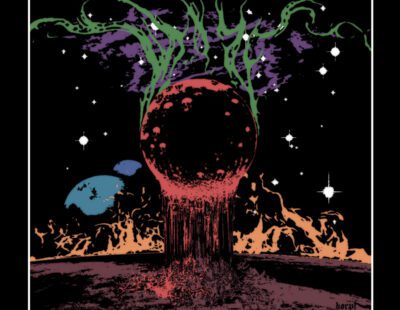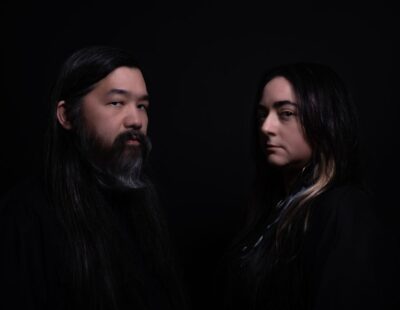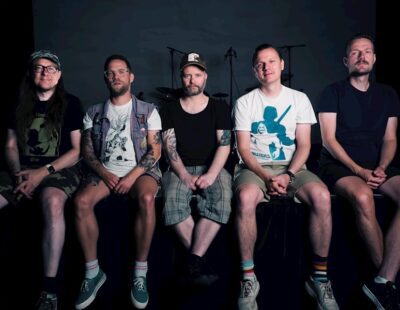
Suffocation. Legends. Savants of the savage. Today marks the 30th birthday of Suffocation’s landmark, Hall of Fame album Effigy of the Forgotten. From its intimidating Dan Seagrave masterpiece cover art to its haunting song titles (“Mass Obliteration,” “Infecting the Crypts,” et al.), Effigy of the Forgotten was a mandatory, day-one purchase on October 8, 1991. Indeed, those that didn’t succumb to Suffocation’s initial brutal allure eventually were drawn back to it. Not by virtue of another look at the wickedly detailed cover art, but by word of mouth alone. In 1991, word spread quickly that the New York powerhouse had issued their much-anticipated debut via Roadrunner imprint R/C, and that it was megatons heavier, faster, more ferocious than the Human Waste EP (released May 1st, 1991). In fact, it was not just a step up but a leap beyond.
Engineered, produced, and mixed by the then-venerable/hype sticker-worthy (and now retired) studio ace Scott Burns at Morrisound Studios in Tampa, Effigy of the Forgotten brutalized right out of the gate. From the first dun-dun riff of opener “Liege of Inveracity,” it was clear Suffocation’s star was rising rapidly from the fetid suburban jungle of Long Island. The maggots were writhing in the wake of what the alien space machines were destroying for sure. It wasn’t just the riffs, courtesy of guitarists Terrance Hobbs and Doug Cerrito, that pummeled, excoriated, and eviscerated hapless death metallers from coast to coast. The hangman vocals of Frank Mullen set a new standard for intensity. Hearing him tear through the lyrics of “Seeds of the Suffering,” “Involuntary Slaughter” and the title track put hairs on end and anxiety in the back of mind. He was a monster, coming for anyone in his path. But Suffocation, unlike many of their peers, put their rhythm players (bassist Josh Barohn and drummer Mike Smith) front and center of the carnage. The opening bass-drum salvo to the title track is brief but killer, and their involvement throughout Effigy of the Forgotten is not just notable but genre-definable. That Mike Smith was able to carve out a new drum pattern–the “Smithblast”–was just another unique trait in Suffocation’s beastly quiver.
It’s with sick, murderous robot-like pleasure that Decibel and Suffocation–via the always excellent Terrance Hobbs–celebrate the 30th Anniversary of Effigy of the Forgotten. As Hobbs used to say 30 years ago holds true today: “stay raw and keep the heaviness.”
Thirty years. What are some of your fondest memories of Effigy of the Forgotten?
Terrance Hobbs: For Effigy, it was us getting signed. We were a bunch of inexperienced kids. For us to be able to go down to record at Morrisound—which, at the time, was the Mecca for death metal and heavy metal—and to work with Scott Burns and Mr. Morris himself was pretty amazing. Plenty of other bands were down there, too. The Deicide guys, the Death guys, the Morbid [Angel] guys and the Cannibal [Corpse] guys were down there. Think about that. It was a really interesting time for us. We were so young and so new to the scene—other than doing demos and tape-trading and stuff—so for us to get that slap of reality in the face, working in a real studio with real engineers, was just awesome. It was something of time and place and era. The technology of the time wasn’t at all like today. Just to be able to look back on Effigy, and all that went into it, is really, really cool.
How did you get signed to Roadrunner? The jump from Relapse to Roadrunner was a big move.
Terrance Hobbs: Well, we were working on a demo and an EP at the same time. Before Roadrunner, it was Matt [Jacobson] and Josh [Barohn] talking to one another. Really, if you look back on Relapse and Nuclear Blast, they didn’t really have a lot of bands on the rosters. Human Waste, I think, brought Relapse and Nuclear Blast together, which gave both more of an international presence, especially in distribution. That’s why we still support Nuclear Blast and Relapse. They were there from the start. There’s a new player on the block called DistroKid, too. We totally support them. But back to Nuclear Blast, we’ve been with them for a very long time, so I have nothing but good things to say about them. We’ll have a new record next year if we can get past this COVID-19 shit. We’re working way slower than we’re used to because our drummer [Eric Morotti] is from Canada, and the borders are closed. They locked all that down, which is making it difficult for us. We have a live album, Live in North America, coming out soon on Nuclear Blast, so hopefully, people will check that out. It sounds amazing!
Who signed you to Roadrunner? I can’t remember if that was Monte [Conner] or a Borivoj [Krgin] move.
Terrance Hobbs: It was Monte. He was always straight up and honest with us. There were a bunch of other people involved. People like Ed Farshtey from Wendigo Productions, Psycho [Mark Abramson] from a Buffalo college radio station, who also interned at Roadrunner at the time, and Josh, our original bass player; he definitely had the gift of gab. I’m glad Monte doesn’t regret signing us. [Laughs] Monte is the man. I’m glad he’s still in the music industry at Nuclear Blast Entertainment. He’s got a lot of knowledge.
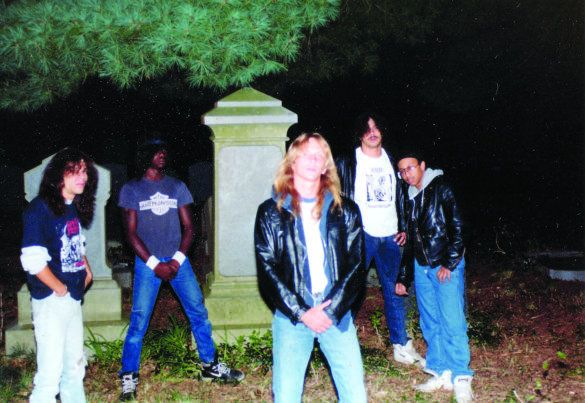
Terrance Hobbs: There’s been a lot of musicians that have passed that affected us in different ways. During our early heydays, we would go out to New Jersey, just to get out of New York for a change. I remember we’d play in places like Camden, which wasn’t the greatest neighborhood. We’d play with bands like Human Remains and Ripping Corpse. We’d also get down to D.C. to play with the guys in Deceased and Abominog. Along the way, we’d play with guys like Immolation, Morpheus Descends, and Prime Evil, who were also playing in New Jersey. Anyway, in Jersey, we’d play at a club called G. Willikers, and this is where we first met the guys in Atheist. We played a gig or two with them, even a few East Coast festivals. We became friends obviously—I remember meeting Kelly [Shaefer], Rand [Burkey], Roger [Patterson], and the rest of the guys—and we’re still friends to this day. I’m happy to see Kelly doing new material, and it sounds killer, let me tell you. OK, I’ll go off in a thousand directions if I don’t stay with Roger. Roger was a go-getter kind of guy. We didn’t have the Internet back then. Just phone calls and mail to keep in touch. He would always stay in touch. Our musical tastes were the same. We had other interests, too. [Laughs] He was a monster player. To know him, see how great he was, and all the energy he put into everything was amazing. To see him go just affected us, man. We had known him for so long. He was one of the brothers. He would be unreal today! Like Jimi Hendrix or Randy Rhoads, right? What would they be doing now? Imagine if Roger were still alive!
What do you remember about the guitar tuning? That was something that set Suffocation apart at the time.
Terrance Hobbs: Back then, there wasn’t the Korn wave, where everybody was playing on seven or eight strings, right? What we did was tune our guitars down a whole step. This got us to C. Then, we went to C Sharp to keep the strings tight. Once you go that low, it’s hard to control the string tension. We didn’t really like that too much. It’s hard to be precise. I mean, we didn’t want to turn our guitars into a bass either. Today, that’s cool and common, but back then, I was more about (and I still am a fan of) standard tuning. I’m more of a traditional guitar player: six strings and standard tuning, maybe a bit lower but not an insane amount. A band notorious for playing in E but still making it sound super-aggressive is Deicide. They didn’t drop tune. I think it’s really cool. Their sound is unique. There’s a fine line between super-noisecore/aggressive and keeping the musicality of things. This is especially true when recording. No matter how great technology gets, it’s not the same as hearing a band play a song at rehearsal a bunch of times. There, you get to hear every note how it’s supposed to be played and sounds. Recordings are like a one-shot deal. You either hear it, or you don’t.
Suffocation pioneered a few new death metal traits. So-called technical death metal, slam death metal and the Smithblast. Thoughts?
Terrance Hobbs: Yeah, the Smithblast. But it was a natural progression for us. We were into what we were into. Heavy metal, hard rock, that kind of shit. As bands started to get progressively faster, our ears really liked that, and I think we thought it was fucking stupendous. Going from thrash like Slayer, Destruction and Metallica to us was natural. We just wanted to go faster and faster. I know Smith [Mike Smith] wanted to. Musically, if it was in that thrash metal, hardcore, death metal-type vein, we were into it, and I think we were playing off all that. I’m glad Smith took on the effort to do all that, too. He brought something new to music. Other than that, we were just aggressive little kids. We didn’t have a formula. Things were still new to us.
Terrance Hobbs: For me, all I can say is thank you! If others have listened to us, emulated us, taken what we’ve done, and moved it forward or to another level, then that’s great! It’s really kind of flattering. I don’t feel it that way, but it’s cool that people acknowledge that we were doing something different back in the day.
That’s what attracted kids to Suffocation. You offered something new. The brutality, musicality, sheer ferociousness of the music was pretty awe-inspiring to kids who were experiencing Suffocation in real-time. I was one of them.
Terrance Hobbs: Well, thanks. Remember, there was still a lot of room for bands to grow at the time. Over the years, people have picked up the pace a lot. There’s so much more out there for kids to learn from—like YouTube—than there was back then. It’s cool, man. The future is a bright place. I can’t wait to hear what kids come up with next. It’s coming, man.
How did the songs come together?
Terrance Hobbs: We were a bunch of kids down in a basement. Obviously, we were fans of heavy metal, and we were writing riffs on our own, so it was just a matter of putting all that together. That’s where the music came from. We’d sit together and play for hours. I think it’s still the same today, actually. Obviously, technology makes that process easier since people can write at home and share it across the Internet. We get together less because we’re playing shows, but I always try to get the band together at my place. We still have the desire to work the way we always have. It’s just a little bit different.
You worked with Scott Burns on Effigy. Tell me about the studio sessions at Morrisound.
Terrance Hobbs: Well, we were offered a few different producers for Effigy. For us, working with Scott, who had just done the Obituary record [Cause of Death], was a no-brainer. We had a lot of friends in Florida. It was a good spot for us to be. He’s an awesome engineer. I learned a lot from him, especially as a kid. The learning experience was fantastic. If I had the chance to work with him again, I’d do it no questions asked. I do remember the sessions were to tape. Obviously, computers weren’t where they are today. When it came down to editing, it was tape on the floor. There was no undo. If I remember correctly, I think we thought we’d go in and punch through everything, but Scott made us sit down, get the right tones, the right gear, pickups, amps, everything! We were young, naïve musicians. He was a proper engineer. It was eye-opening to us. It was way more work than we thought it was going to be. You know, 24-channel, reel-to-reel-type stuff. Scott made us sound incredible. He did an amazing job. Scott’s an A-class engineer.
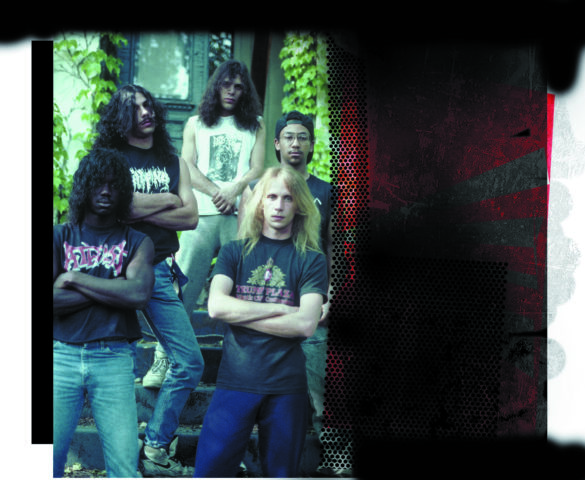
Terrance Hobbs: We’ve always liked in-depth cover art. Like Altars of Madness or Malleus Maleficarum. There’s always something new to see. The Effigy cover is one of our favorites. I mean, we were mallrat kids. When we went into Record Stop or Tape World, we were always looking for the craziest covers. If the cover was explicit, we were like, “Oh shit! We gotta get this!” Anything that had to do with science fiction, fucked up faces, guitars, laser beams, horror, dark, and shitty stuff, I was into. I was such a fanboy. I remember we got Darkness Descends and Reign in Blood because we liked the cover art. That shit blew our minds! [Laughs] Goosebumps. I blew up the Slayer cassette because I played it so much. Fucking insane! Not to lose track of the question, but I think you can see something is wrong in the band on the Breeding cover. I’m not a big fan of that cover. We were having a hard time in the studio up here. The band wasn’t doing well. That cover is a reflection of how bad things were for us. The cover is a scar. The production wasn’t the greatest, especially considering how good the music was. We managed to pick it back up on Pierced from Within, which was done by Hiro Takahashi. I will say Souls to Deny is also one of my favorites. Pinnacle of Bedlam is also a great cover. I like the Suffocation cover, too. It was meant to be very bleak. But shit, man, Effigy will always be my favorite. There’s no fucking with that cover. [Laughs]
Do you remember how Effigy was received by the underground?
Terrance Hobbs: That’s exactly it. The underground. It was there but small. It blew up when people eventually got used to it. That took a while. I think it was received very well. We were kids, though. We didn’t understand the music business. We didn’t understand touring, offers, and things like that. We really couldn’t do the things that were requested of us. We had signed our lives away to a record company that nobody knew anything about. Maybe that was as part of our downfall. I think if we had better tour opportunities and stuff like that, things could’ve been different. I mean, I remember when the Death record [Spiritual Healing] came out. Chuck, god rest his soul, went about things in a way that always kept Death in the spotlight. That definitely helped Death’s career. We lacked whatever that was.
Touring for Effigy kicked off in 1992. Any specific memories about your first regional and national tours with Suffocation?
Terrance Hobbs: We did tours in ’92 and ’93. They were like six weeks long. We were in a van. That was a tough run. We went out with Vader and Dismember. I think Defiance was on one of the legs. That was one of our earliest actual tours of the states.
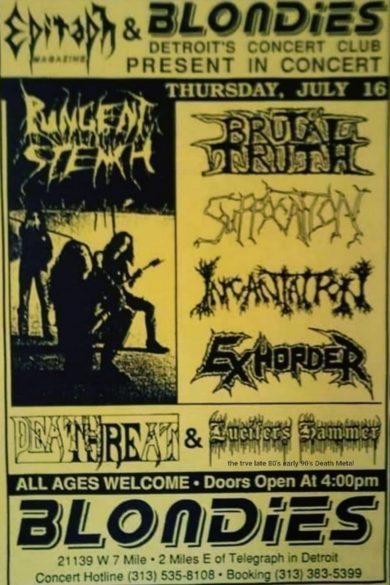
Terrance Hobbs: Yeah, that was a spot show. We drove in for that show. That was a great gig, man. They definitely had a little scene there with Metal Mom [Sandy Newton] and Lucifers Hammer. I think we got a lot of momentum by coming out there to play. That’s why you saw us playing together all the time. We’d get brought out there all the time. We played a lot of gigs back then, but it was spotty. It wasn’t until ’96 that we really started to tour, but we broke up two years later. Only when we got back together did the touring start to become endless, which I was always thankful for. I’d rather be on the road, man. [Laughs]
What are your final thoughts on Effigy?
Terrance Hobbs: I think it’s an album that was a great experience. The guys I had, coming out of school. I wouldn’t change anything. The recording. The technique we had. What it took to play. How we approached music. That said, it being 30 years old, I never thought anyone would’ve paid attention to it. It is underground music. I’m thankful I’m able to do it to this very day. I’m thankful to all the fans. They’ve been there from the beginning. To the bands that are out there doing it like they were doing in the ’90s, all respect. That said, I wouldn’t change anything about Effigy. Not a fucking thing.
Suffocation links:
1. Decibel inducts Effigy of the Forgotten into the Hall of Fame. LINK.
2. Suffocation Shop @ Nuclear Blast. LINK.
3. Facebook. LINK.
4. Instagram. LINK.
5. YouTube. LINK.
More 30th Anniversary Interviews::
1. Immolation – Dawn of Possession. LINK.
2. Dismember – Like an Ever Flowing Stream. LINK.
3. Autopsy – Mental Funeral. LINK.




